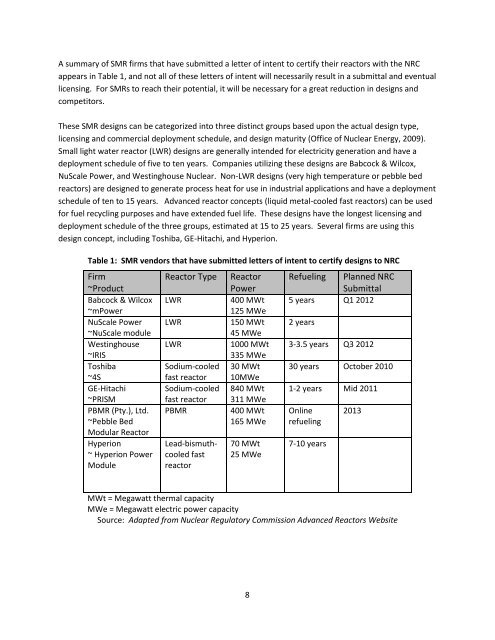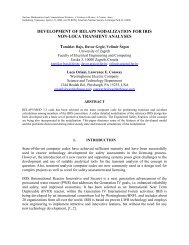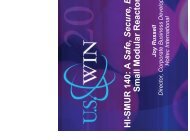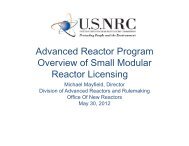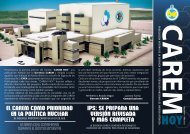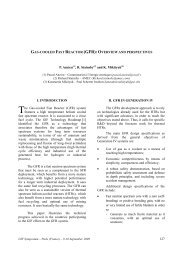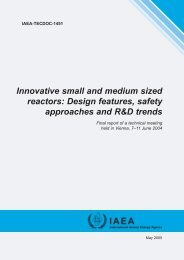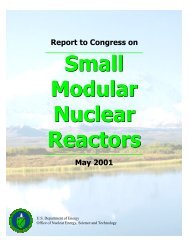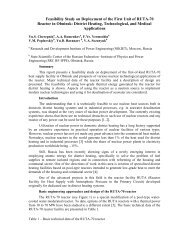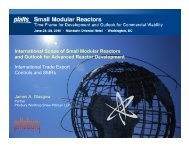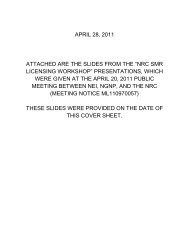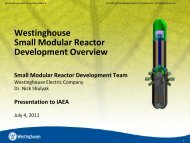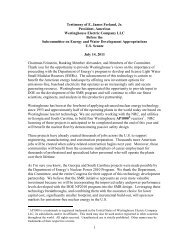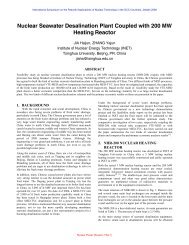Economic and Employment Impacts of Small Modular Reactors - SMR
Economic and Employment Impacts of Small Modular Reactors - SMR
Economic and Employment Impacts of Small Modular Reactors - SMR
- No tags were found...
Create successful ePaper yourself
Turn your PDF publications into a flip-book with our unique Google optimized e-Paper software.
A summary <strong>of</strong> <strong>SMR</strong> firms that have submitted a letter <strong>of</strong> intent to certify their reactors with the NRC<br />
appears in Table 1, <strong>and</strong> not all <strong>of</strong> these letters <strong>of</strong> intent will necessarily result in a submittal <strong>and</strong> eventual<br />
licensing. For <strong>SMR</strong>s to reach their potential, it will be necessary for a great reduction in designs <strong>and</strong><br />
competitors.<br />
These <strong>SMR</strong> designs can be categorized into three distinct groups based upon the actual design type,<br />
licensing <strong>and</strong> commercial deployment schedule, <strong>and</strong> design maturity (Office <strong>of</strong> Nuclear Energy, 2009).<br />
<strong>Small</strong> light water reactor (LWR) designs are generally intended for electricity generation <strong>and</strong> have a<br />
deployment schedule <strong>of</strong> five to ten years. Companies utilizing these designs are Babcock & Wilcox,<br />
NuScale Power, <strong>and</strong> Westinghouse Nuclear. Non-‐LWR designs (very high temperature or pebble bed<br />
reactors) are designed to generate process heat for use in industrial applications <strong>and</strong> have a deployment<br />
schedule <strong>of</strong> ten to 15 years. Advanced reactor concepts (liquid metal-‐cooled fast reactors) can be used<br />
for fuel recycling purposes <strong>and</strong> have extended fuel life. These designs have the longest licensing <strong>and</strong><br />
deployment schedule <strong>of</strong> the three groups, estimated at 15 to 25 years. Several firms are using this<br />
design concept, including Toshiba, GE-‐Hitachi, <strong>and</strong> Hyperion.<br />
Table 1: <strong>SMR</strong> vendors that have submitted letters <strong>of</strong> intent to certify designs to NRC<br />
Firm<br />
~Product<br />
Babcock & Wilcox<br />
~mPower<br />
NuScale Power<br />
~NuScale module<br />
Westinghouse<br />
~IRIS<br />
Toshiba<br />
~4S<br />
GE-‐Hitachi<br />
~PRISM<br />
PBMR (Pty.), Ltd.<br />
~Pebble Bed<br />
<strong>Modular</strong> Reactor<br />
Hyperion<br />
~ Hyperion Power<br />
Module<br />
Reactor Type<br />
LWR<br />
LWR<br />
LWR<br />
Sodium-‐cooled<br />
fast reactor<br />
Sodium-‐cooled<br />
fast reactor<br />
PBMR<br />
Lead-‐bismuth-cooled<br />
fast<br />
reactor<br />
Reactor<br />
Power<br />
400 MWt<br />
125 MWe<br />
150 MWt<br />
45 MWe<br />
1000 MWt<br />
335 MWe<br />
30 MWt<br />
10MWe<br />
840 MWt<br />
311 MWe<br />
400 MWt<br />
165 MWe<br />
70 MWt<br />
25 MWe<br />
Refueling Planned NRC<br />
Submittal<br />
5 years Q1 2012<br />
2 years<br />
3-‐3.5 years Q3 2012<br />
30 years October 2010<br />
1-‐2 years Mid 2011<br />
Online<br />
refueling<br />
7-‐10 years<br />
2013<br />
MWt = Megawatt thermal capacity<br />
MWe = Megawatt electric power capacity<br />
Source: Adapted from Nuclear Regulatory Commission Advanced <strong>Reactors</strong> Website<br />
8


